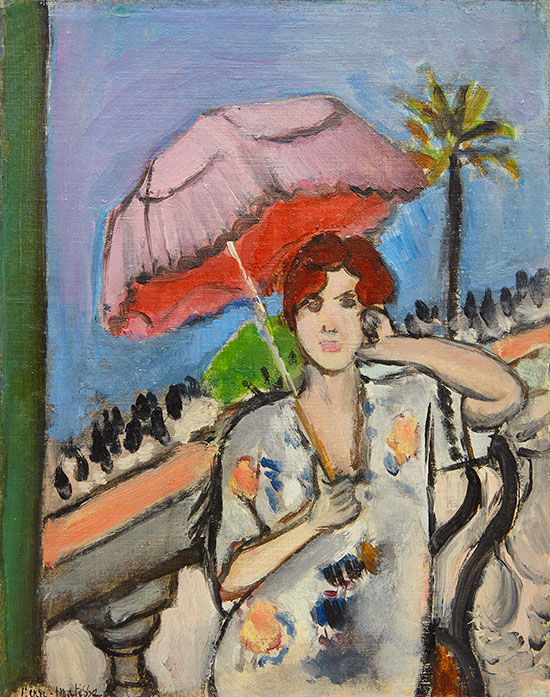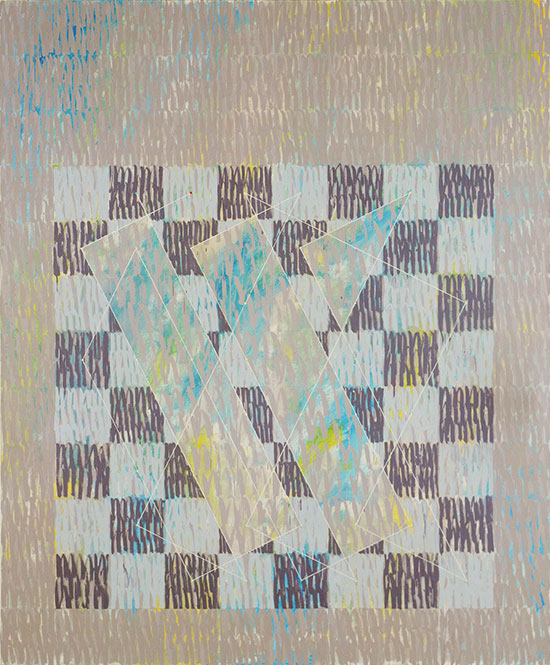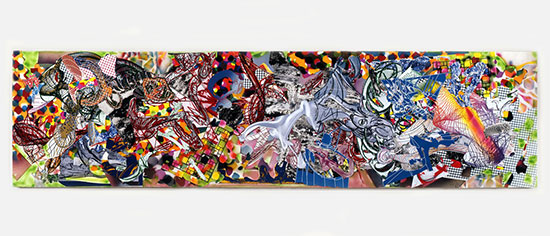The tempo to take in the The Art Show at the Park Avenue Armory through Sunday, March 6, 2016 is allegro con brio. For the musically uninitiated, this would be: at a fast tempo with spirit.
This top tier and often surprising reimagining of the country’s longest-running art fair gathers the crème de la crème, 72 galleries from 100 proposals, from the Art Dealers Association of America (ADAA). In an ambitious tribute to the sophistication of the New York fair-going public, several booths pushed the envelope this year with historic rediscoveries or debut work.
As the fair coincided with the sprawling and more cutting edge The Armory Show (confusingly held on the Hudson piers) and myriad other fairs, including the upstart Spring/Break in the Post Office building in midtown, the club-like dignity of the ADAA gathering was a determined way to elevate the tone of the modern day conception of the art fair.
The ADAA show at the Armory also raised the quality bar. Soaring well over it, Acquavella Galleries trotted out a seductive painting by Henri Matisse of a coquette on the Cote d’Azur under a parasol. Painted in oil on canvas board in 1919, it overflows with white sunlight and Mediterranean blue, bounded on the left edge by a band of green.
.

"Femme a l'ombrelle" by Henri Matisse, 1919. Oil on canvas board. Courtesy Acquavella Galleries, New York, NY.
.
The Matisse, along with a group of Miro gouache paintings at the booth of Jeffrey Loria, and the Egon Schiele and Gustav Klimt works on paper at the Galerie St. Etienne, conferred a High Modernist blessing on the gathering.
Among the Schiele works, the oddly elevated point of view and extended fingers of the Standing Semi-Nude with Brown and Red Vest, Back View (Torso), made in 1913, was completely memorable. The top lot in the booth, though, was a major reclining nude painting in oil, with a fascinating texture, by Paula Modersohn-Becker. Its rarity (the artist died at 31) as well as its technical aplomb make the painting one of the must-see attractions at the fair.
Some works just stop the lover of paint in his or her tracks, like a triptych by Sean Scully at Mnuchin. This piece’s pulsing undertones and the forward thrust of the central panel caught all the light perfectly. Then attention was deftly redirected in the booth to one of the great paintings on a Classical theme by Cy Twombly, inscribed to Virgil, and the allure of major talent at a major gallery was complete.
.

"Triptych" by Sean Scully, 1984. Oil on canvas, 42 x 81 1/2 inches. © Sean Scully. Courtesy Mnunchin Gallery.
.
Trusting viewers to keep pace with intellectual and historical challenges, several galleries presented significant statements, including three different booths devoted to the work of African-American artists. Long a reliable authority in this area, Michael Rosenfeld held a mini retrospective of Beauford Delaney (1901-1979), while Betty Cunningham featured Bill Traylor.
My favorite discovery among the three was the work of McArthur Binion, chosen by Galerie Lelong for a one-person exhibition of work from the 1970s. Large-scale, subtly colored oil paint stick on canvas and paper, these absorbing works made this a great call on the part of Lelong. Born in Macon, Mississippi, and raised in Detroit, Binion was the first black graduate of the Cranbrook Academy in 1973. His paintings were a highlight of the fair.
Binion, who attended the opening night of the fair, said that he hoped “to evoke the tactile pleasure of all-over abstraction and combine it with the responsibility of representation.”
Gently twining kinetic sculptures and works on paper by the German artist Rebecca Horn, including some “body landscape” paintings, filled the Sean Kelly Gallery with exquisite delicacy. In a similar tone, the gestures of cutting, slicing, stitching and tearing linked the work of Kiki Smith, Derrick Adams, Alighiero Boetti, Spencer Finch, Gordon Matta-Clark, Richard Tuttle and, inevitably, Lucio Fontana at Rhona Hoffman.
The poetry of these two booths, along with the genuinely bold “distribution” of rolls of gray felt, aluminum rods and ball bearings scattered on the floor at the David Nolan booth by Barry le Va (reprising the idea for an installation at the artist’s studio in 1967), offered a vast improvement on the usual marketplace experience of an art fair.
Uncovering a little-known period in a major artist’s work is a daring and invaluable mission, not usually attempted in this kind of high-pressure setting. That is why I particularly admired Alexander Gray for mounting a show of Jack Tworkov’s “Knight Series” from 1975-1977.
Known for his gestural abstract expressionism, Tworkov was an intellectual in the Robert Motherwell mode who played chess and was fascinated by the geo-political messages the game could send, including statements on the Vietnam War encoded in the knight’s moves across the board.
.

"Knight Series #2 (Q3-75 #3)" by Jack Tworkov, 1975. Oil on canvas, 90 x 75 inches. Courtesy Alexander Gray Associates, New York. © 2015 Jack Tworkov / Licensed by VAGA, New York, NY.
.
The works in the “Knight Series” were made just three years after the epic world championship match between Bobby Fischer and Boris Spassky, the elevation of chess to Cold War battle. Tworkov enlisted his formidable mark-making and chromatic talents in a more conceptual approach to large-scale abstraction, including a brilliant rhythmic riff on the grid of the board that is straight from his more famous work. How splendid to uncover a whole chapter in a major career, and to find such a rich vein of imagery where abstraction had been the story.
A more academic version of this kind of discovery was offered by Hans P. Kraus, who combined two paintings by Edward Steichen with some of the soft focus photographs for which Steichen is best known, including a stunning portrait of William Merritt Chase.
Steichen often presented himself as a painter, but the fascinating thing about the two paintings was how different they were from one another. One was a Whistlerian landscape thought to have been painted in Mamaroneck in 1904 (where he made a famous photograph of the moonrise that year), all atmospherics and crepuscular tones. The other is a bold, Expressionist figural work, a 1909 portrait of his friend Selma Stieglitz Schubart (Alfred Stieglitz’s youngest sister) with overtones of Edvard Munch.
As in the studio, chance and choice play their roles in what goes into an art fair. The most fortuitous moment, for this visitor, was the side-by-side blockbuster effect of a vast Helen Frankenthaler painting at Berggruen (brought all the way from San Francisco) with a comparably epic Frank Stella at Dominique Levy in a “joint presentation” (according to press materials) with Marianne Boesky.
Coming on the heels of the huge Whitney retrospective, and resembling the vast print in that show made in conjunction with Ken Tyler, Stella’s Severambia (Side B) is a collage that marches 256 inches across and 66 inches high, as full of his sound and fury as the Baroque paintings he celebrated in his brilliant book on Working Space. Passers-by veered into the booth at the sight of it, and gathered there at the end of the fair preview on Tuesday as though in its embrace.
.

"Severanbia (side B)" by Frank Stella, 1995. Collage on paper, 66 x 256 inches. © 2015 Frank Stella / Artists Rights Society (ARS), New York. Courtesy of the artist, Marianne Boesky Gallery, New York, Dominique Levy, New York/London, & Spruth Magers, Berlin.
.
The Frankenthaler next door, Moveable Blue (1973) is a billowing force of nature, a major work from a great moment in her career. I found myself returning again and again to the two booths just to bask in the radiance of two major works in the same format, like massive Chinese landscape scrolls, practically side by side.
.

"Moveable Blue" by Helen Frankenthaler, 1973. Acrylic on canvas, 70 x 234 1/4 inches. © 2014 Helen Frankenthaler Foundation, Inc./Artists Rights Society (ARS), New York.
.
______________________________
BASIC FACTS: The Art Show Organized by the Art Dealers Association of America takes place from March 2 to 6, 2016 at Park Avenue Armory at 67th Street. www.artdealers.org.
______________________________
Copyright 2016 Hamptons Art Hub LLC. All rights reserved.
